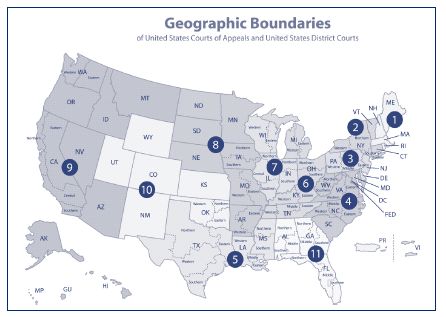U.S. federal courts have frequently been referred to as the "guardians of the Constitution." Under Article III of the Constitution, federal judges are appointed for life by the U.S. president with the approval of the Senate. They can be removed from office only through impeachment and conviction by Congress. The first bill considered by the U.S. Senate—the Judiciary Act of 1789—divided the U.S. into what eventually became 12 judicial "circuits." In addition, the court system is divided geographically into 94 "districts" throughout the U.S. Within each district is a single court of appeals, regional district courts, bankruptcy appellate panels (in some districts), and bankruptcy courts.

As stipulated by Article III of the Constitution, the Chief Justice and the eight Associate Justices of the Supreme Court hear and decide cases involving important questions regarding the interpretation and fair application of the Constitution and federal law. A U.S. court of appeals sits in each of the 12 regional circuits. These circuit courts hear appeals of decisions of the district courts located within their respective circuits and appeals of decisions of federal regulatory agencies. Located in the District of Columbia, the Court of Appeals for the Federal Circuit has nationwide jurisdiction and hears specialized cases such as patent and international trade cases. The 94 district courts, located within the 12 regional circuits, hear nearly all cases involving federal civil and criminal laws. Decisions of the district courts are most commonly appealed to the district's court of appeals.
Bankruptcy courts are units of the federal district courts. Unlike that of other federal judges, the power of bankruptcy judges is derived principally from Article I of the Constitution, although bankruptcy judges serve as judicial officers of the district courts established under Article III. Bankruptcy judges are appointed for a term of 14 years (subject to extension or reappointment) by the federal circuit courts after considering the recommendations of the Judicial Conference of the United States. Appeals from bankruptcy-court rulings are most commonly lodged either with the district court of which the bankruptcy court is a unit or with bankruptcy appellate panels, which presently exist in five circuits. Under certain circumstances, appeals from bankruptcy rulings may be made directly to the court of appeals.
Two special courts—the U.S. Court of International Trade and the U.S. Court of Federal Claims—have nationwide jurisdiction over special types of cases. Other special federal courts include the U.S. Court of Appeals for Veterans Claims and the U.S. Court of Appeals for the Armed Forces.
The content of this article is intended to provide a general guide to the subject matter. Specialist advice should be sought about your specific circumstances.


